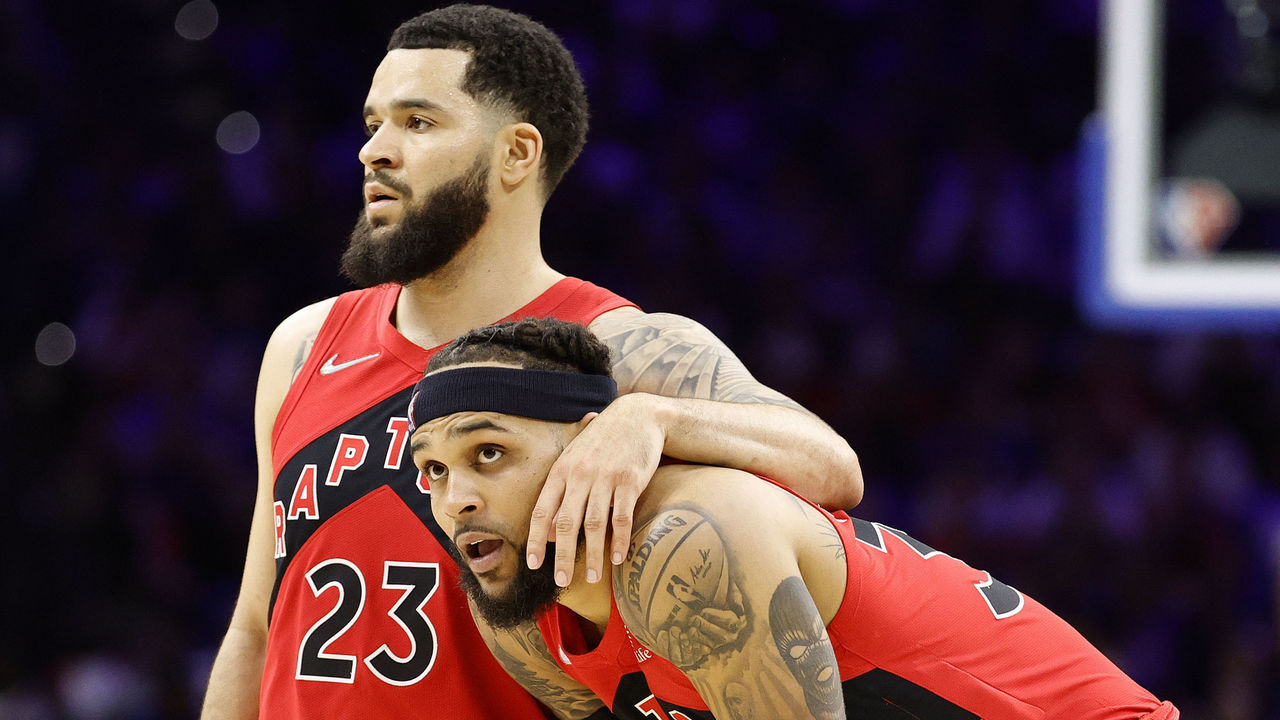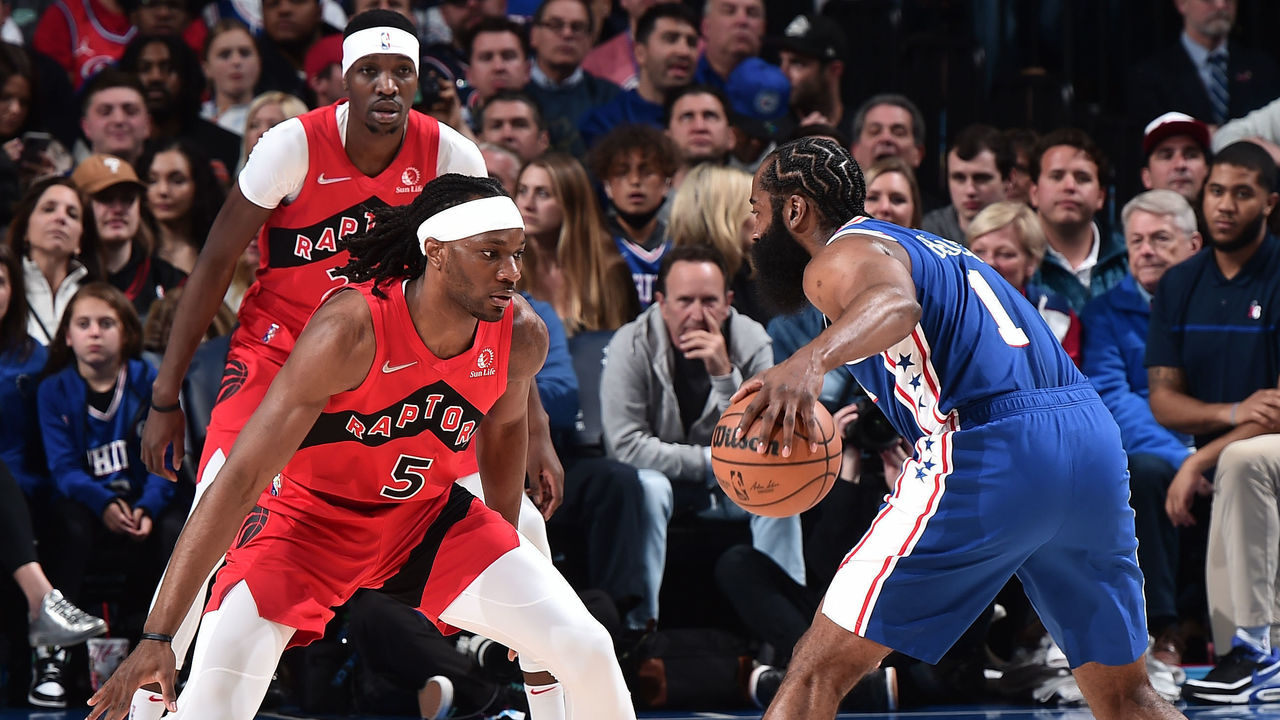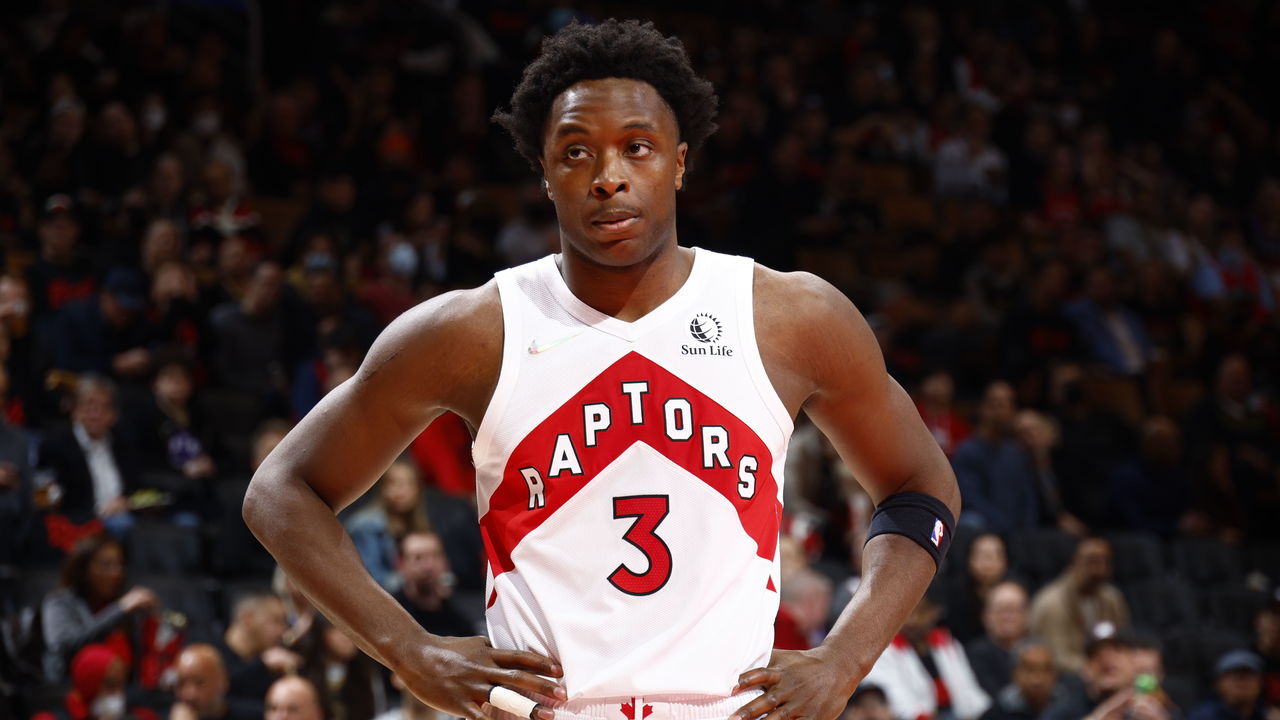How can the Raptors take the next step?
The NBA isn't as stylistically homogeneous as some curmudgeonly critics like to suggest, but there's undeniably a lot of overlap in the ways teams try to succeed, and a near-uniform acknowledgment of the particular amalgam of skills required to win big in this day and age.
When it comes to offensive and defensive objectives - the type of shots teams hunt and the ones they aim to take away from their opponents - we tend to see a lot of paths converge on the same destination.
It's fascinating, then, to track the small handful of teams that zag while the rest of the league zigs. And there isn't a more unique experiment in zagging right now than what the Toronto Raptors are doing.
Much like last season, almost everyone in Toronto's projected rotation entering 2022-23 stands between 6-foot-7 and 6-foot-9. Only one player on the roster exceeds that height band (7-foot-1 rookie center Christian Koloko), and only two major rotation players - Fred VanVleet (generously listed at 6-foot-1) and Gary Trent Jr. (6-foot-5) - come in below it. VanVleet and Trent were the only two Raptors classified as guards who even cracked the 600-minute threshold last season. In short: the Raptors are huge at the wing positions and quite small at point guard and center.

A team arming itself with long, positionally ambiguous, defensively interchangeable athletes isn't some galaxy-brain idea, but the strategy sticks out in Toronto's case. To this point it has come at the expense of shooting, off-the-dribble creation, pick-and-roll proficiency, and interior scoring - things virtually every other team with aspirations of contending has placed a premium on.
The Raptors' collective length and athleticism allows them to create and thrive in chaos, but it doesn’t help them solve set defenses. They're a team made up almost entirely of playmaking power forwards, but outside of Pascal Siakam, the playmaking in most of those cases is still fairly limited.
Shotmaking was a clear issue for the Raptors last season - they ranked 28th in 2-point percentage and 20th in 3-point percentage - but so was their shot diet, which saw them rank 23rd in 3-point attempt rate, 25th in free-throw attempt rate, and 26th in rim frequency. During an era in which everyone ostensibly wants to generate threes, shots at the rim, and free throws, Toronto managed to grind out 48 wins while being one of the worst teams in the league in all three categories.
Additionally, despite playing in transition more often than any team outside of Memphis, the Raptors finished a mere 16th in overall offensive pace because their laborious half-court possessions took longer than anyone else's.
Even at the defensive end of the floor, where their bread is ostensibly buttered, the Raptors' hyper-aggressive scheme - designed to generate live-ball turnovers partly as a way to mask their offensive deficiencies - produced a suboptimal shot spectrum, a ton of fouls, and a very poor rebounding rate. Their opponents dined out on the kind of high-value shots the Raptors themselves struggled to create: corner threes and free throws.
While the Raptors did a solid job of limiting opponents' attempts at the rim, conceding them at the NBA's 13th-lowest rate, their constant scrambling and relative lack of size at center meant they didn't defend those attempts particularly well, allowing the league's ninth-highest field-goal percentage on shots inside the restricted area, per Cleaning the Glass.

All told, Toronto mustered a significantly worse true shooting percentage (54.3%, 27th in the NBA) than it allowed (57.5%, 22nd). That made the team's .585 winning percentage and plus-2.2 net rating feel like some kind of magic trick.
So, there are a couple of different ways to interpret the Raptors' 2021-22 campaign as we look ahead, following an offseason in which they did very little to change their roster. Was last season the first stepping stone for a rising power showcasing an influential brand of basketball? Or was it the high-water mark for a flawed team that, barring a personnel shakeup, will struggle to repeat the feat in an improved Eastern Conference?
The optimistic view is that Toronto improved as last season went along, with core young pieces like Scottie Barnes and Precious Achiuwa making particularly meaningful strides, while Siakam rediscovered his All-NBA form and then some after starting the season injured. The team collectively struggled at first to nail down the complexities of Nick Nurse's ball-pressuring, help-conscious defense, ranking dead last in defensive efficiency for a whole calendar month before righting the ship. Once those issues were resolved, Toronto took off, going 34-17 with the league's sixth-best defensive rating from New Year’s Eve onward.
The Raptors were working in a bunch of new pieces last year, and roundly believe their roster carry-over will allow them to hit the ground running this season, especially on defense.
"I think for me, having a good understanding of the system, trying to share that understanding was difficult," VanVleet, a veteran of Nurse's scheme, said of last season's early hiccups. "Because you have to go through live reps, and breakdowns, and you have to make a ton of mistakes before you can learn it. But I think we're in a good spot now, pretty much everybody has an understanding of what we're trying to do."

O.G. Anunoby, the best individual defender on the team, said the hardest part of defending in the Raptors' system is sustaining energy, focus, and communication while navigating a long cycle of rotations over the course of a possession. "Communicating, making the next rotation, talking as the possession goes on ... It's easy at the beginning, but (the challenge is) at the end, continuing to talk and be there for the next man."
Anunoby thinks last season's newcomers are now fully acclimated to those challenges, after spending a big chunk of the 2021-22 campaign learning the ropes. "Everyone knows the (initial) rotations, next rotations, where everyone's going to be," he said. "So, everyone's on the same page now, more so than we were last year in the beginning."
Nurse, for his part, thinks the Raptors are "way further ahead" of where they were at the start of last season, but added: "We've learned a few lessons as well, and we see the same kind of yearly recurring issues that we know we've got to fix."
Are those issues fixable, though?
On top of an important developmental offseason for their cadre of promising young players, the Raptors should get a boost from free-agent signee Otto Porter Jr., a killer 3-point shooter and savvy off-ball mover who will alleviate some of the half-court spacing concerns. There certainly looks to be more depth than there was last year. Better health for core veterans Siakam, VanVleet (who had an All-Star season derailed by knee and hip injuries), and Anunoby (who spent nearly half the season sidelined) would also go a long way. There are avenues to improvement, no doubt.
But here's the pessimistic view: Most of Toronto's limitations from last season seem likely to remain limitations, and getting to 48 wins required herculean feats of engineering that will be hard to replicate, let alone improve upon. Can the Raptors once again produce a gargantuan possession advantage to offset their shotmaking deficit? Can they continue to hammer the offensive glass while surrendering the league’s lowest rate of opponent transition chances? Can they cobble together another league-average offense simply by outrunning and outworking the opposition?
Even if they can follow that same blueprint with no diminishing returns, taking a meaningful step forward with this group will likely require internal growth in unforeseeable ways: non-shooters becoming shooters, spot-up threats becoming pull-up threats, shaky handlers refining their ball skills, finishers becoming connectors, connectors becoming initiators. That's what it will take, for instance, to achieve Nurse's stated goal of dramatically increasing the team's volume of at-rim shots.

"I think getting to the front of the rim opens up the 3-ball, and we certainly want our share of catch-and-shoot threes," he told reporters on media day. "So, I would hope that emphasizing the front end of our shot spectrum would kind of smooth out the overall shot spectrum."
Whether or not Nurse even has that order of operations right - does pressuring the rim open up threes, or does having 3-point threats open up the rim? - it's unclear the Raptors as currently constructed have the means to fulfill his wishes.
Siakam is by far their most effective driver, but he constantly had to navigate thickets of help defenders last season because of the dearth of shooting around him. VanVleet's handle lets him probe to his heart’s content, but he lacks straight-line burst and has always struggled to finish at the rim when he gets there. Trent is a side-to-side mover with very little north-south juice. Barnes can be a wicked interior finisher - via cuts, rolls, high-low feeds, or lay-downs to the dunker spot - but outside of the odd keeper play, he's yet to demonstrate the ball-handling chops to consistently get himself to the basket. That's something he'll be able to do eventually, but he'll likely improve incrementally.
Perhaps jumbo ball-handler Dalano Banton can build on his promising offseason and provide that missing downhill element. Maybe Koloko can help right away as a live-wire pick-and-roll target for a squad that finished fewer possessions via roll men than all but two teams, and ranked 27th in scoring efficiency on the rare occasions it did so. If Achiuwa's late-season 3-point boom proves sustainable, he can theoretically space the floor for others on top of drawing closeouts that allow him to access his explosiveness as a pump-and-go driver. Maybe Anunoby can fully actualize the on-ball ability he's teased in glimpses for years. Maybe this is the year Malachi Flynn puts it all together as a pick-and-roll playmaker. Porter's off-ball gravity could widen the driving lanes enough to give everyone a boost.
That's a lot of ifs and maybes. On top of which, there's the open question of whether a defense that voluntarily puts itself in rotation and concedes bushels of corner threes by design is the optimal use of the talented individual defenders on the roster. Toronto profiles as a versatile defensive team because it features so many like-sized, malleable defenders, but that in itself doesn't necessarily translate to collective flexibility. The Raptors as a unit are capable of playing a lot of different styles, but they're so unyielding with their help principles that they can become predictable.
Perhaps having a healthier offense would allow them to dial back some of the aggressiveness. Or maybe simply having a 7-footer anchoring the back line would do the trick. Interchangeability has its benefits, but it isn't everything. The Raptors should know this as well as anyone, having crafted one of the most adaptable defenses of the last decade with a starting lineup that featured VanVleet, Kyle Lowry, and Marc Gasol - two miniscule guards and a lumbering center.

All of this is to say, these Raptors are an enigma; simultaneously big and small, fast and slow, versatile and rigid. It's hard to know what to make of them, or suss out where this is all headed. As fun and refreshing as it is to watch a team innovate and swim against the current, trends are trends for a reason, and disrupting them is extremely difficult. There's a thin line between bucking convention and simply lacking the wherewithal to succeed conventionally.
It's also evident the Raptors' brass is aware of the holes on the roster and is looking for ways to patch them up. The fact the team just drafted Koloko, and has come up repeatedly in trade rumors surrounding established centers like Myles Turner, Jakob Poeltl, and Deandre Ayton, suggests the front office isn't fully sold on the idea of having wingy 6-foot-9 guys manning the five on a full-time basis. The fact Malcolm Brogdon was reportedly pursued this offseason before the Pacers sent him to Boston suggests they recognize the need for more ball-handling and dribble-drive rim pressure.
Time will tell whether they continue chasing those kinds of upgrades on the trade market throughout this season, or are content to wait things out and see how this version of the team can grow. One way or another, the Raptors' progress as they look to build on last year's weird, wild, inventive, and surprisingly successful campaign will be among the most interesting NBA stories to track in the months to come.